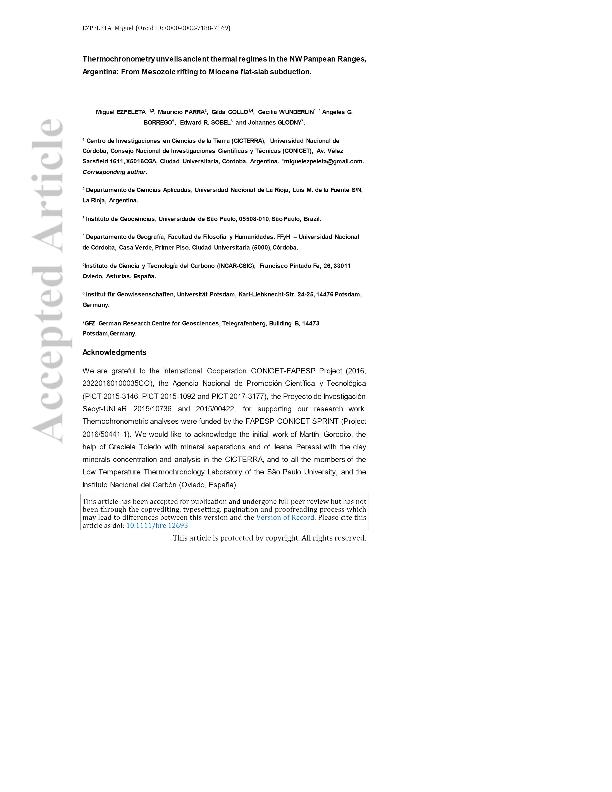Mostrar el registro sencillo del ítem
dc.contributor.author
Ezpeleta, Miguel

dc.contributor.author
Parra, Mauricio
dc.contributor.author
Collo, Gilda

dc.contributor.author
Wunderlin, Cecilia Ayelén

dc.contributor.author
Borrego, Angeles G.
dc.contributor.author
Sobel, Edward Robert

dc.contributor.author
Glodny, Johannes

dc.date.available
2023-07-12T17:39:30Z
dc.date.issued
2022-12
dc.identifier.citation
Ezpeleta, Miguel; Parra, Mauricio; Collo, Gilda; Wunderlin, Cecilia Ayelén; Borrego, Angeles G.; et al.; Thermochronometry unveils ancient thermal regimes in the NW Pampean Ranges, Argentina: From Mesozoic rifting to Miocene flat-slab subduction; Wiley Blackwell Publishing, Inc; Basin Research; 34; 6; 12-2022; 1983-2012
dc.identifier.issn
0950-091X
dc.identifier.uri
http://hdl.handle.net/11336/203549
dc.description.abstract
Reconstructing thermal histories in thrust belts is commonly used to infer the age and rates of thrusting and hence the driving mechanisms of orogenesis. In areas where ancient basins have been incorporated into the orogenic wedge, a quantitative reconstruction of the thermal history helps distinguish among potential mechanisms responsible for heating events. We present such a reconstruction for the Ischigualasto-Villa Unión basin in the western Pampean Ranges of Argentina, where Triassic rifting and late Cretaceous-Cenozoic retroarc foreland basin development has been widely documented, including Miocene flat-slab subduction. We report results of organic and inorganic thermal indicators acquired along three stratigraphic sections, including vitrinite reflectance and X-ray diffractometry in claystones and new thermochronological [(apatite fission-track and apatite and zircon [U-Th]/He)] analyses. Despite up to 5 km-thick Cenozoic overburden and unlike previously thought, the thermal peak in the basin is not due to Cenozoic burial but occurred in the Triassic, associated with a high heat flow of up to 90 mWm−2 and <2 km of burial, which heated the base of the Triassic strata to ~160°C. Following exhumation, attested by the development of an unconformity between the Triassic and Late-Cretaceous–Cenozoic sequences, Cenozoic re-burial increased the temperature to ~110°C at the base of the Triassic section and only ~50°C 7 km upsection, suggesting a dramatic decrease in the thermal gradient. The onset of Cenozoic cooling occurred at ~10−8 Ma, concomitant with sediment accumulation and thus preceding the latest Miocene onset of thrusting that has been independently documented by stratigraphic–cross-cutting relationships. We argue that the onset of cooling is associated with lithospheric refrigeration following establishment of flat-slab subduction, leading to the eastward displacement of the asthenospheric wedge beneath the South American plate. Our study places time and temperature constraints on flat-slab cooling that calls for a careful interpretation of exhumation signals in thrustbelts inferred from thermochronology only.
dc.format
application/pdf
dc.language.iso
eng
dc.publisher
Wiley Blackwell Publishing, Inc

dc.rights
info:eu-repo/semantics/openAccess
dc.rights.uri
https://creativecommons.org/licenses/by-nc-sa/2.5/ar/
dc.subject
%RO
dc.subject
CENOZOIC FLAT-SLAB
dc.subject
ISCHIGUALASTO-VILLA UNION BASIN
dc.subject
THERMOCHRONOLOGICAL MODELLING (AFT, AHE AND ZHE)
dc.subject
TRIASSIC RIFTING
dc.subject
XRD IN THE CLAY FRACTION
dc.subject.classification
Geología

dc.subject.classification
Ciencias de la Tierra y relacionadas con el Medio Ambiente

dc.subject.classification
CIENCIAS NATURALES Y EXACTAS

dc.title
Thermochronometry unveils ancient thermal regimes in the NW Pampean Ranges, Argentina: From Mesozoic rifting to Miocene flat-slab subduction
dc.type
info:eu-repo/semantics/article
dc.type
info:ar-repo/semantics/artículo
dc.type
info:eu-repo/semantics/publishedVersion
dc.date.updated
2023-07-07T17:16:41Z
dc.journal.volume
34
dc.journal.number
6
dc.journal.pagination
1983-2012
dc.journal.pais
Reino Unido

dc.journal.ciudad
Londres
dc.description.fil
Fil: Ezpeleta, Miguel. Universidad Nacional de La Rioja; Argentina. Consejo Nacional de Investigaciones Científicas y Técnicas. Centro Científico Tecnológico Conicet - Córdoba. Centro de Investigaciones en Ciencias de la Tierra. Universidad Nacional de Córdoba. Facultad de Ciencias Exactas Físicas y Naturales. Centro de Investigaciones en Ciencias de la Tierra; Argentina
dc.description.fil
Fil: Parra, Mauricio. Universidade de Sao Paulo; Brasil
dc.description.fil
Fil: Collo, Gilda. Consejo Nacional de Investigaciones Científicas y Técnicas. Centro Científico Tecnológico Conicet - Córdoba. Centro de Investigaciones en Ciencias de la Tierra. Universidad Nacional de Córdoba. Facultad de Ciencias Exactas Físicas y Naturales. Centro de Investigaciones en Ciencias de la Tierra; Argentina
dc.description.fil
Fil: Wunderlin, Cecilia Ayelén. Consejo Nacional de Investigaciones Científicas y Técnicas. Centro Científico Tecnológico Conicet - Córdoba. Centro de Investigaciones en Ciencias de la Tierra. Universidad Nacional de Córdoba. Facultad de Ciencias Exactas Físicas y Naturales. Centro de Investigaciones en Ciencias de la Tierra; Argentina
dc.description.fil
Fil: Borrego, Angeles G.. Instituto Nacional del Carbón; España
dc.description.fil
Fil: Sobel, Edward Robert. Universitat Potsdam. Mathematisch Nautrwissenschaften Fakultat. Institut Fur Geowissenschaften. Allgemeine Geologie; Alemania
dc.description.fil
Fil: Glodny, Johannes. German Research Centre for Geosciences; Alemania
dc.journal.title
Basin Research

dc.relation.alternativeid
info:eu-repo/semantics/altIdentifier/doi/http://dx.doi.org/10.1111/bre.12693
dc.relation.alternativeid
info:eu-repo/semantics/altIdentifier/url/https://onlinelibrary.wiley.com/doi/10.1111/bre.12693
Archivos asociados
